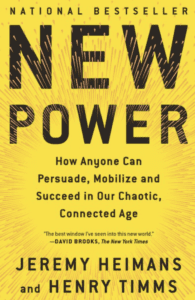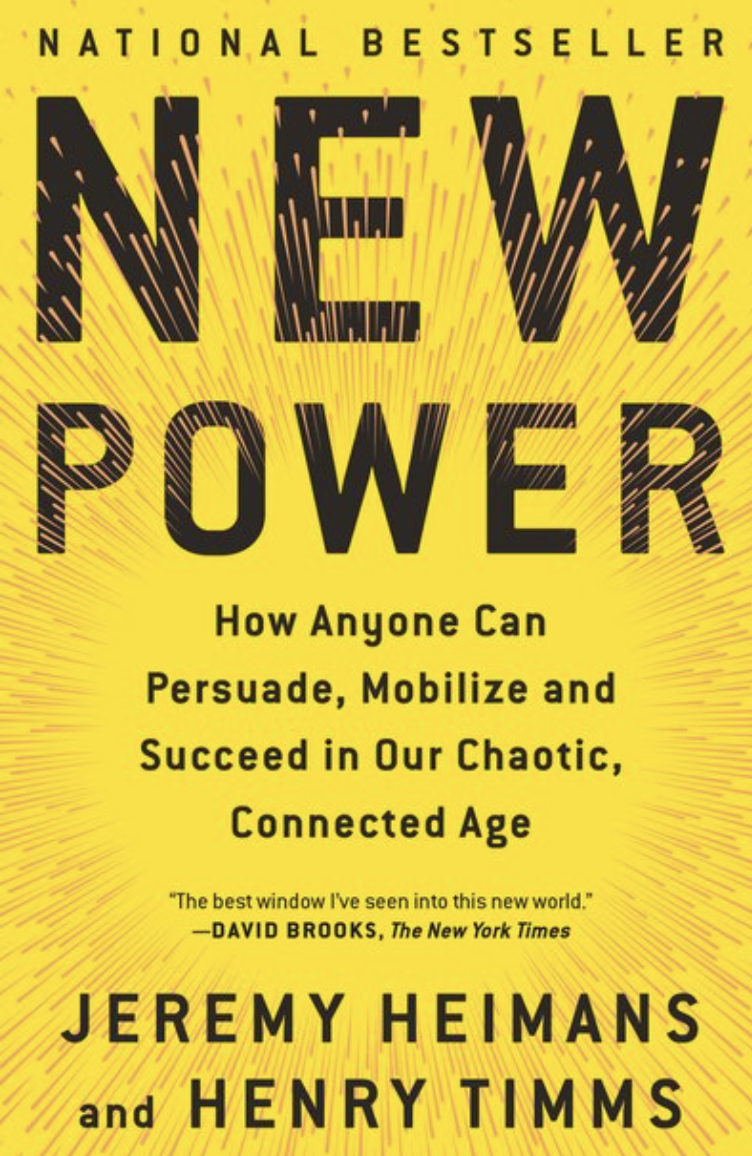In organizations such as Independent Schools rich in history, precedent, tradition and long-standing community members (faculty and families), there is a lot of inertia to move these schools into position of agility, responsiveness and ‘new’. “New Power: How anyone can persuade, mobilize and succeed in our chaotic connected age”, by Heimans and Timms, offers a very insightful look at the benefits and pitfalls of this inertia, and challenges and opportunities to becoming agile and responsive. Ultimately, it is up to the organization to determine what traditional muscles, and which muscles of innovation to exercise.
and long-standing community members (faculty and families), there is a lot of inertia to move these schools into position of agility, responsiveness and ‘new’. “New Power: How anyone can persuade, mobilize and succeed in our chaotic connected age”, by Heimans and Timms, offers a very insightful look at the benefits and pitfalls of this inertia, and challenges and opportunities to becoming agile and responsive. Ultimately, it is up to the organization to determine what traditional muscles, and which muscles of innovation to exercise.
This book position “Old Power” as:
– operating like currency
– power is held by the few
– once gained, it is guarded against losing it
– closed / inaccessible /leader-driven
Conversely, “New Power” is:
– like a current
– power is generated by many
– participatory and peer-driven
– it uploads and distributes
– not hoarded, but channeled
You would be interested in the book if you:
1) Are leader in schools looking to spark, support and maintain innovation
2) Want to engage younger powers who are more in tune with “new power”
3) Want to learn more about how to balance new and old power for the value of your students and community
4) Want to explore the changing nature of power
What is New and Old Power:
The authors capture, really nicely, the tension between new and old power, writing: “New power models are enabled by the activity of the crowd…In contrast, old power models are enabled by what people or organizations own, know or control that nobody else does – once old power models lost that [grasp], they lose their advantage.”
They cite examples of companies and experiences of leaders who work within these two different power models, and critical questions to ask as well:
How do you switch between old and new power?
When should you blend them together?
When will old power actually produce better outcomes?
These are critical questions because they ask those of us who lean into innovation and New Power models, to slow down and really appreciate the Old Power models and how they can be used to add value to the organization. Best captured by this chart: What might we learn when we examine these organizations, their purpose and outcomes:
From Make it Stick to Make it Spread
You may recall the Heath brothers successful book “Make it Stick”, and the message of S.U.C.C.E.S (Simple, Unexpected, Concrete, Credible, Emotional Stories). There is still very much a time and place for this approach; however, “…the rise of New Power is asking us to consider some new principles, too.” (pg. 37) More and more, we are looking to not only consume, but to contribute; we are looking for ways to share and not contain knowledge; we are looking for ways to spread ideas of others, not just tell our own stories / take our own credit. To have successful New Power approach, the authors use A.C.E. (Actionable, Connected, and Extensible).
The authors use the Ice Bucket Challenge as an excellent example of the A.C.E. approach. Independent schools can learn much from this approach, as the world changes and local markets change too. Action: How do we allow our community to engage and take action with us to support our mission, vision, and values? Connected: How do we ensure that our families are extending their connection to our schools with others through building partnerships and word of mouth? Extensible: How can we allow our families to build on, add to, extend what we do here elsewhere, and bring our mission, vision and values to their own lived experiences?
But Wait…
What I liked about the approach that these authors took is that they don’t say that New Power is the only way to go. Rather, they offer up examples of when Old Power and New Power can work together. They cite a few examples that David Price, author of “The Power of Us”, first wrote about: BrewDog, a brewery in the UK, Minecraft, Star Citizen and, Obama vs. Trump leadership and campaigns, and yes, Boaty McBoat Face. These serve as examples of when New Power and Old Power can serve positive and destructive ends.
 They also go on to provide examples of leadership of New and Old Power, and the learnings from these examples. They cite four leadership archetypes:
They also go on to provide examples of leadership of New and Old Power, and the learnings from these examples. They cite four leadership archetypes:
– Co-opters (New Power Model but Old Power Values)
– Castles (Old Power Model & Old Power Values)
– Crowd Leaders (New Power Model & New Power Values)
– Cheerleaders (Old Power Model but New Power Values)
And they provide a decision-tree to help leaders make choices about when to apply New Power Values and Approaches, and when to apply Old Power Value and Approaches. This I found really interesting as a reflective exercise in strategy roll-outs.
I really enjoyed this book and would recommend it, but it is lengthy in the details and examples. The authors also have an HBR article: HERE.



